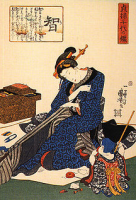Sewing has an ancient history estimated to begin during the Paleolithic Age. Sewing was used to stitch together animal hides for clothing and for shelter. The Inuit, for example, used sinew from caribou for thread and needles made of bone, the indigenous peoples of the American Plains and Canadian Prairies used sophisticated sewing methods to assemble tipi shelters. Sewing was combined with the weaving of plant leaves in Africa to create baskets, such as those made by Zulu weavers, who used thin strips of palm leaf as ""thread"" to stitch wider strips of palm leaf that had been woven into a coil. The weaving of cloth from natural fibres originated in the Middle East around 4000 BCE, and perhaps earlier during the Neolithic Age, and the sewing of cloth accompanied this development.
Sewing underwent further developments during the 20th century. As sewing machines became more affordable to the working class, demand for sewing patterns grew. Women had become accustomed to seeing the latest fashions in periodicals during the late 19th and early 20th centuries, increasing demand for sewing patterns yet more. American tailor and manufacturer Ebenezer Butterick met the demand with paper patterns that could be traced and used by home sewers. The patterns, sold in small packets, became wildly popular. Several pattern companies soon established themselves. Women's magazines also carried sewing patterns, and continued to do so for much of the 20th century. This practice declined during the last decades of the 20th century, when ready-made clothing became a necessity as women joined the paid workforce in larger numbers, leaving them with less time to sew, if indeed they had an interest. Today, the low price of ready-made clothing in shops means that home sewing is confined largely to hobbyists in Western countries.
The spread of sewing machine technology to industrialized economies around the world meant the spread of Western-style sewing methods and clothing styles as well. In Japan, traditional clothing was sewn together with loose chain stitches that were removed so that the clothing could be taken apart and the assorted pieces laundered separately. The tight-locked stitches made by home sewing machines, and the use of Western clothing patterns, led to a movement towards wearing Western-style clothing during the early 20th century.Western sewing and clothing styles were disseminated in sub-Saharan Africa by Christian missionaries from the 1830s onward. Indigenous cultures, such as the Zulu and Tswana, were indoctrinated in the Western way of dress as a sign of conversion to Christianity. First Western hand sewing techniques, and later machine sewing, spread throughout the regions where the European colonists settled. However, a recent examination of new online learning methods demonstrated that technology can be adapted to share knowledge of a culture's traditional sewing methods. Using self-paced online tutorials, a Malay sewing class learned how to tailor and sew a traditional men's Baju Kurung garment in 3 days, whereas a traditional Malay sewing class would have taken 5 days to teach the same information.
Advances in industrial technology, such as the development of synthetic fibres during the early 20th century, have brought profound changes to the textile industry as a whole. Textile industries in Western countries have declined sharply as textile companies compete for cheaper labour in other parts of the world. According to the U.S. Department of Labor ""employment of sewers and tailors is expected to experience little or no change, growing 1 percent from 2010 to 2020"".It is estimated that every lost textile job in a Western country in recent years has resulted in 1.5 jobs being created in an outsourced country such as China.Textile workers who perform tasks with sewing machines, or do detailed work by hand, are still a vital component of the industry, however. Small-scale sewing is also an economic standby in many developing countries, where many people, both male and female, are self-employed sewers.








